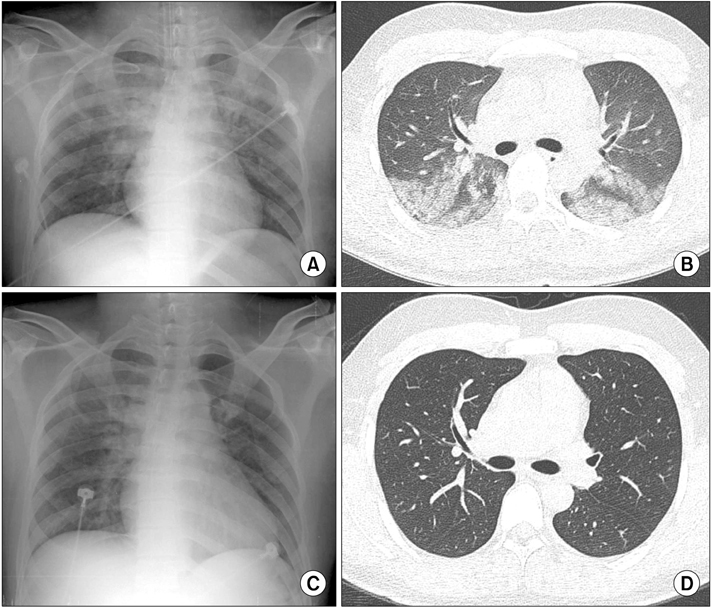Tuberc Respir Dis.
2013 Mar;74(3):120-123.
Acute Respiratory Distress Due to Methane Inhalation
- Affiliations
-
- 1Department of Internal Medicine, Keimyung University Dongsan Medical Center, Keimyung University School of Medicine, Daegu, Korea. wichoi@dsmc.or.kr
- 2Department of Radiology, Keimyung University School of Medicine, Daegu, Korea.
Abstract
- Inhalation of toxic gases can lead to pneumonitis. It has been known that methane gas intoxication causes loss of consciousness or asphyxia. There is, however, a paucity of information about acute pulmonary toxicity from methane gas inhalation. A 21-year-old man was presented with respiratory distress after an accidental exposure to methane gas for one minute. He came in with a drowsy mentality and hypoxemia. Mechanical ventilation was applied immediately. The patient's symptoms and chest radiographic findings were consistent with acute pneumonitis. He recovered spontaneously and was discharged after 5 days without other specific treatment. His pulmonary function test, 4 days after methane gas exposure, revealed a restrictive ventilatory defect. In conclusion, acute pulmonary injury can occur with a restrictive ventilator defect after a short exposure to methane gas. The lung injury was spontaneously resolved without any significant sequela.
MeSH Terms
Figure
Reference
-
1. Byard RW, Wilson GW. Death scene gas analysis in suspected methane asphyxia. Am J Forensic Med Pathol. 1992. 13:69–71.2. Terazawa K, Takatori T, Tomii S, Nakano K. Methane asphyxia: coal mine accident investigation of distribution of gas. Am J Forensic Med Pathol. 1985. 6:211–214.3. Kucuker H. Occupational fatalities among coal mine workers in Zonguldak, Turkey, 1994-2003. Occup Med (Lond). 2006. 56:144–146.4. Knoblauch A, Steiner B. Major accidents related to manure: a case series from Switzerland. Int J Occup Environ Health. 1999. 5:177–186.5. Beaver RL, Field WE. Summary of documented fatalities in livestock manure storage and handling facilities: 1975-2004. J Agromedicine. 2007. 12:3–23.6. Baldursdottir S, Sigvaldason K, Karason S, Valsson F, Sigurdsson GH. Induced hypothermia in comatose survivors of asphyxia: a case series of 14 consecutive cases. Acta Anaesthesiol Scand. 2010. 54:821–826.7. Wallace GM, Brown PH. Horse rug lung: toxic pneumonitis due to fluorocarbon inhalation. Occup Environ Med. 2005. 62:414–416.8. Parra ER, Noleto GS, Tinoco LJ, Capelozzi VL. Immunophenotyping and remodeling process in small airways of idiopathic interstitial pneumonias: functional and prognostic significance. Clin Respir J. 2008. 2:227–238.9. Weibrecht KW, Rhyee SH. Acute respiratory distress associated with inhaled hydrocarbon. Am J Ind Med. 2011. 54:911–914.
- Full Text Links
- Actions
-
Cited
- CITED
-
- Close
- Share
- Similar articles
-
- A Case of Acute Respiratory Distress Syndrome Caused By Zinc Fume Inhalation
- Maintenance of nitric oxide inhalation to a patient with hemoperitonium and acute respiratory distress syndrome during anesthesia: A case report
- Treatment of Acute Respiratory Distress Syndrome
- A Case of Pumpless Extracorporeal Interventional Lung Assist Application in a Patient with Severe ARDS Who Is Severe Burn with Inhalation Lung Injury: A Case Report
- Combined Effects of Inhaled Nitric Oxide and a Recruitment Maneuver in Patients with Acute Respiratory Distress Syndrome


